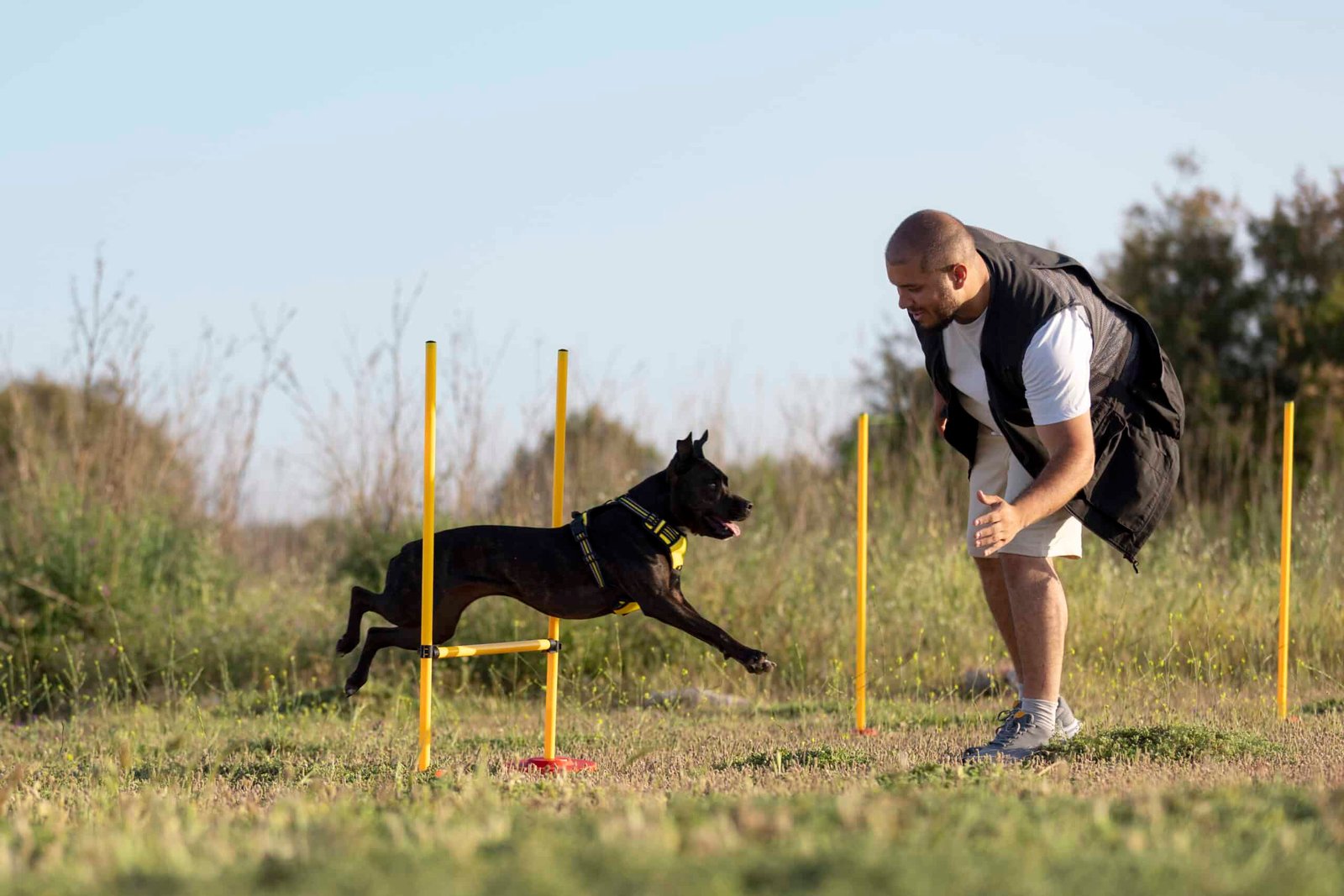Have you ever wondered how our methods of training dogs have changed over the years? In this article, we will explore the fascinating evolution of dog training techniques. From early coercive methods to modern positive reinforcement techniques, you’ll discover how our understanding of dogs’ behavior and psychology has shaped the way we train man’s best friend. So grab a treat and get ready to embark on a journey through time as we uncover the transformation of dog training techniques.
The Beginning of Dog Training
The Domestication of Dogs
Dog training has come a long way since the early days of domestication. Thousands of years ago, humans began to form bonds with canines, recognizing their intelligence and loyalty. As humans and dogs started coexisting, it became evident that training was necessary to ensure the harmonious integration of dogs into human society. This marked the beginning of dog training as we know it today.
Early Training Techniques
In the early stages of dog training, techniques were often rudimentary and based on trial and error. The focus was primarily on teaching dogs to perform basic tasks that would assist humans in their day-to-day lives. Dogs were trained to help with hunting, herding livestock, guarding properties, and even pulling sleds. These early training methods relied heavily on commands and signals, with rewards and punishment playing a significant role in the process.
Traditional Dog Training Methods
Dominance-Based Training
One traditional approach to dog training was dominance-based training. This method stemmed from the belief that dogs operated within a hierarchical pack structure and needed a strong leader. Dominance-based training centered around establishing dominance over the dog through assertive actions, such as alpha rolls and physical corrections. While some success was achieved with this method, it had its drawbacks, often leading to fear or aggression in dogs.
Punishment-Based Training
Another commonly utilized technique in traditional dog training was punishment-based training. This approach relied on the use of physical punishment or harsh reprimands to discourage unwanted behaviors. It focused on correcting dogs through aversive measures like leash corrections, loud noises, or even physical corrections. However, this type of training often caused anxiety and stress in dogs and could damage the trust between the dog and its owner.
Command-Based Training
Command-based training was another prevalent method employed in traditional dog training. This technique primarily relied on commands to shape a dog’s behavior. Dogs were taught to respond to verbal cues and hand signals to perform specific actions. While command-based training can be effective to some extent, it focuses on compliance rather than understanding, potentially limiting a dog’s ability to think and problem-solve independently.
Understanding Canine Behavior
Scientific Discoveries in Canine Behavior
Advancements in scientific research have revolutionized our understanding of canine behavior. Over time, researchers have uncovered fascinating insights into the cognitive abilities and social dynamics of dogs. Studies have shown that dogs possess intelligence, emotional sensitivity, and a remarkable ability to communicate with humans and their fellow canines. Such discoveries have paved the way for new, more effective training techniques based on a deeper understanding of a dog’s natural inclinations.
The Importance of Positive Reinforcement
One key discovery in canine behavior research emphasized the importance of positive reinforcement. Positive reinforcement is a training method that rewards desired behaviors with treats, praise, or playtime, reinforcing the behavior and encouraging its repetition. This approach enhances the bond between the dog and its trainer, as it creates positive associations and motivates dogs to engage willingly in the learning process. Positive reinforcement focuses on reward rather than punishment, promoting a more compassionate and effective training experience.
Positive Reinforcement Training
Rewards-Based Training
Rewards-based training is a popular positive reinforcement technique used by many modern dog trainers. In this method, dogs are rewarded with treats, toys, or verbal praise when they exhibit the desired behavior. This positive feedback motivates dogs to repeat the behavior, reinforcing their learning. By associating rewards with specific actions, dogs learn to perform tasks willingly and happily, leading to better retention and improved overall behavior.
Clicker Training
Clicker training is a specific type of positive reinforcement training that employs a clicker as a marker signal. The clicker emits a distinct sound when pressed, signaling to the dog that it has performed the correct behavior. The sound is immediately followed by a reward, reinforcing the behavior. Clicker training allows for precise timing and accuracy in marking desired behaviors, enabling dogs to quickly understand the correlation between actions and rewards.
Marker Training
Marker training is similar to clicker training but utilizes a verbal or visual signal, such as the word “yes” or a thumbs-up gesture, to mark the desired behavior. This technique eliminates the need for a physical clicker and allows trainers to provide instantaneous feedback to the dog. Marker training has proven to be highly effective in facilitating clear communication between trainers and dogs, enhancing the training process.
The Rise of Dog Psychology
Methods Inspired by Dog Psychology
In recent years, the field of dog psychology has gained significant attention, thanks in part to the work of renowned dog behaviorist Cesar Millan. Millan’s holistic approach to dog training, grounded in the understanding of a dog’s instinctual behavior as part of a pack, has shaped modern training techniques. By incorporating principles of leadership, balance, and calm assertiveness, trainers can establish a harmonious relationship with their dogs, addressing behavioral issues from a psychological standpoint.
Understanding Pack Dynamics
Dog psychology emphasizes the understanding of pack dynamics and how they influence a dog’s behavior. Dogs are social animals by nature, and their instinctual pack mentality plays a crucial role in their interactions. By recognizing and respecting a dog’s need for clear leadership, structure, and socialization, trainers can effectively guide their dogs towards desired behaviors. Understanding pack dynamics allows trainers to provide the necessary support and guidance to create a balanced and confident dog.
Cognitive Training for Dogs
Using Mental Stimulation for Training
Training dogs involves more than just teaching basic commands and behaviors. Cognitive training focuses on stimulating a dog’s mental abilities to enhance their problem-solving skills and overall intelligence. Engaging in interactive games, puzzles, and tasks that challenge a dog’s cognitive abilities can promote mental stimulation and prevent boredom, leading to a happier and more well-rounded companion.
Problem-Solving and Puzzle Training
Introducing problem-solving and puzzle training into a dog’s routine can be highly beneficial. These activities require dogs to actively engage their minds and use their problem-solving abilities to achieve a desired outcome. Puzzle toys, for example, can be filled with treats that dogs must figure out how to access. This type of training not only exercises a dog’s brain but also helps them develop critical thinking skills and boosts their confidence in overcoming challenges.
Technological Advances in Dog Training
Electronic Training Tools
In recent years, technological advances have introduced electronic training tools to the market. Devices such as electronic collars, invisible fences, and remote training systems have become increasingly popular. These tools can provide a range of stimuli, from gentle vibrations and sounds to mild corrective shocks, to help reinforce training commands. When used appropriately and with proper guidance, electronic training tools can be effective aids in shaping desired behaviors.
Virtual Training Platforms
The digital age has also given rise to virtual training platforms that offer interactive and personalized training experiences. These platforms allow trainers to connect with dog owners remotely, offering guidance, demonstrations, and customized training plans. Virtual training platforms provide convenient access to expert guidance, particularly for those who may have limited access to in-person training classes or live in remote areas. This innovative approach to training offers flexibility and convenience while still prioritizing positive reinforcement methods.
Holistic Approaches to Dog Training
Alternative Training Methods
Holistic approaches to dog training take into account not only a dog’s behavioral needs but also their overall well-being. Alternative training methods encompass a variety of techniques, including dog yoga, aromatherapy, and massage therapy. These holistic practices aim to create a calm and peaceful environment for dogs, promoting relaxation and reducing stress and anxiety during training sessions. While the effectiveness of these methods may vary, they can complement traditional training techniques and contribute to a dog’s overall happiness and welfare.
Natural and Herbal Remedies
In addition to alternative training methods, natural and herbal remedies have gained popularity among dog owners seeking gentle and non-invasive solutions for various behavioral issues. Products such as pheromone diffusers, herbal calming supplements, and essential oil blends have been developed to promote relaxation and reduce anxiety in dogs. While it is essential to consult with a veterinarian before using any natural remedies, these options provide owners with additional tools to support their dog’s well-being during the training process.
Fostering Positive Relationships
Emphasizing Trust and Bonding
Building a strong foundation of trust and bonding is essential in dog training. Dogs are highly receptive to the energy and emotions of their owners, and maintaining a positive and supportive relationship is crucial for effective training. By creating a safe and nurturing environment, trainers can establish trust and encourage open communication. Positive reinforcement techniques further enhance the bond between dog and trainer, reinforcing the dog’s confidence and eagerness to learn.
Including the Whole Family in Training
Dog training is not solely the responsibility of one person. Involving the whole family in training sessions helps establish consistency in commands, expectations, and rewards. It also deepens the bond between family members and the dog. When everyone is actively engaged in the training process, it reinforces the dog’s understanding of the desired behaviors and prevents confusion or mixed messages. Moreover, the shared experience of training can be a fun and rewarding activity for the whole family to enjoy.
Training for Canine Sports and Activities
Agility Training
Canine sports, such as agility training, have gained popularity as both recreational activities and competitive sports. Agility training involves navigating a course of obstacles, including jumps, tunnels, and weave poles, in a timed manner. This type of training enhances a dog’s physical fitness, coordination, and mental agility while reinforcing obedience and communication with the handler. Agility training provides an outlet for a dog’s energy and stimulates their natural instincts, promoting a healthy and well-rounded lifestyle.
Scent Detection Training
Scent detection training taps into a dog’s exceptional olfactory abilities and is often employed in working dog roles such as search and rescue or narcotics detection. Dogs are trained to locate and indicate the presence of specific scents, such as drugs or missing persons. This type of training engages a dog’s mental capabilities, challenging them to analyze and identify different scents in various environments. Scent detection training can also provide mental stimulation for dogs, contributing to their overall well-being.
Therapy Dog Training
Therapy dog training focuses on preparing dogs to provide comfort and support to individuals in need, whether in hospitals, schools, or other settings. These trained animals offer emotional support and assistance to people experiencing physical, emotional, or psychological difficulties. Therapy dog training emphasizes temperance, obedience, and socialization, ensuring that these specially trained dogs are well-behaved and reliable in various situations. Therapy dog training further exemplifies the positive impact that well-trained dogs can have in society.
As dog training techniques have evolved over time, the focus has shifted from dominance and punishment to positive reinforcement and a holistic understanding of a dog’s needs. With advancements in canine behavior research and the application of innovative training methods, dog training has become more effective, humane, and enjoyable for both dogs and their owners. By prioritizing positive relationships, mental stimulation, and a comprehensive approach to training, we can continue to strengthen the bond between humans and their canine companions while fostering well-rounded and obedient dogs.


